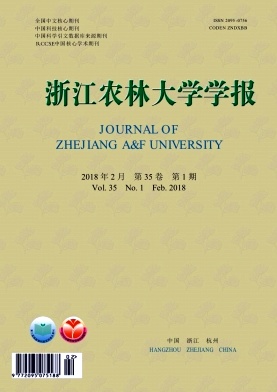-
根系是植物吸收土壤水分和养分的重要营养器官,并通过自身周期性的衰老死亡和分解作用参与土壤生态过程[1]。根系的空间分布决定了林木吸收土壤水分和营养空间的大小[2]。林木新根数量、长度和有效吸收面积等决定了根系吸收水分和养分的能力[3-4]。而直径≤2 mm的根,由于吸收表面积大、生理活性强等特点,在水分和养分吸收上发挥着重要的作用[5]。VOGT等[6]研究表明:在植物生长季中,粗根变化不明显,细根的变化较为明显。对于经济林来说,根系是果树栽培的基础。果园改土、灌溉、施肥等基本栽培措施都要通过根系对地上部分产生影响[7]。根系对于提高果实品质也有影响。目前,对果树根系进行了大量研究,张劲松等[8]对太行山低山丘陵区石榴Punica granatum吸水根的研究表明:石榴吸水根在垂直方向上主要集中在0~80 cm,水平方向上主要集中在0~100 cm。云雷等[9]对晋西黄土区核桃Juglans regia-花生Arachis hypogaea复合系统核桃根系的研究表明,核桃根系垂直方向上主要集中在0~60 cm,水平方向上主要集中在距核桃1.5 m的区域内。高琛稀等[10]对1年生矮化自根砧苹果Malus pumila苗木的研究表明:地下根系在6月和9月生长旺盛,7月和8月死亡较多。这一系列的研究对指导果树施肥和灌溉发挥了重要的作用。板栗Castanea mollissima原产中国,在中国分布范围较广,是中国重要的木本粮食作物之一,其抗病能力强、果实含糖量高、糯性强和易剥离等优点,深受广大消费者喜爱。提高板栗的产量和品质是许多学者比较关心的问题,而目前的研究主要集中在修剪、施肥、授粉等方面[11-13],对板栗根系的研究却鲜有报道。因此,本研究通过对板栗细根季节性动态及空间分布特征的研究,以期为生产中确定合理的施肥和灌溉制度,提高果树产量和质量提供科学依据。
HTML
-
研究区域位于河北省迁西县北京林业大学经济林(板栗)育种与栽培实践基地。该地区地势平坦,属于东部季风暖温带半湿润气候,年平均气温为10.9 ℃,最冷月(1月)平均气温-6.5 ℃,最热月(7月)平均气温25.4 ℃,年平均降水量为744.7 mm,主要集中在7月和8月。全年日照时数为2 581.5 h,无霜期为176 d。试验地成土母质为片麻岩,土壤质地为沙壤土,土壤类型为褐土。试验地土壤理化性质见表 1。
土层深度/cm 容重/(g·m-3) 总孔隙度/% pH值 有机质/(g·kg-1) 碱解氮/(mg·kg-1) 有效磷/(mg·kg-1) 速效钾/(mg·kg-1) 0~20 1.51 43.07 6.48 6.11 51.42 22.53 157.61 20 ~40 1.42 46.37 6.68 6.55 46.55 18.72 125.51 40 ~60 1.47 44.41 7.59 5.56 38.85 16.58 123.12 Table 1. Physical and chemical properties of the soils at the experiment site
-
研究对象是位于示范园内的6年生板栗,林带内植株密度为2 m × 3 m(株距为2 m,行距为3 m),平均树高2.4 m,平均地径6.6 cm,采用中等强度的管理措施。在研究区域内设置3个40 m × 40 m的标准地,选择标准木(接近平均树高和平均地径的树木)21株·样地-1。采用连续根钻法,土钻内径为8 cm,于2016年4-10月生长季内,每月10-15日选择样本3株·样地-1,以样本为中心,东西南北4个方向为取样区,距树干50 cm,100 cm处钻取土芯,分3层(0~20,20~40,40~60 cm)取样。试验为期6个月,共计分析7次样品。
-
根样取回后先在水中浸泡,然后用水冲洗,过100目筛使根系与土壤等分离,重复数次。本研究采用传统的根系分类方法[14],将直径≤2 mm的根系归为板栗细根。然后将洗净的根系放在清水中,用镊子捡取所有的细根。根据细根的外形、颜色、弹性区别死根和活根。装入自封袋内放入冰箱内低温保存。本研究只统计活细根的特征,活细根用Epson Twain Pro根系扫描仪扫描获取图像。扫描时将根系放在透明塑料板上,用镊子将各条根系充分展开,扫描后的图像用WinRhizo根系分析系统进行分析。分析后的活根置于80 ℃的烘箱中烘干至恒量,用电子天平称量(精确到0.001 g)。以此来估算生物量。
-
根长密度(m·m-3)=L/[πr2h·10-4];根质量密度(g·m-3)=m土芯/[πr2h·10-4]。其中:L为土芯根长;m土芯为土芯根质量;r为土钻半径,为4 cm;h为土层深,为20 cm。
-
使用SPSS 20.0软件进行数据统计分析,采用单因素方差分析(one-way ANOVA)和Duncan法比较不同土层深度、不同距离的差异性及不同月份的差异性,应用Excel 2007进行图表制作。
1.1. 试验样地概况
1.2. 研究方法
1.2.1. 根系取样
1.2.2. 根系分析
1.2.3. 根系指标计算
1.3. 统计方法
-
从4-10月板栗细根根长密度和根质量密度的总平均值来看(表 2),随着土层的变化,细根根长密度和根质量密度均表现出明显的变化趋势。在0~60 cm土层中,总细根根长密度为3 824.6 m·m-3,其中20~40 cm土层中最多,占总细根根长密度的43.03%。细根的总根质量密度在0~60 cm土层为554.2 g·m-3,与细根的根长密度相同,在20~40 cm土层中也是最多的,占总细根根质量密度的45.35%。细根根长密度和根质量密度的最大值均出现在距树干100 cm处的20~40 cm土层中。方差分析表明:随着土层的加深,细根的根长密度和根质量密度的变化差异显著(P<0.05)。
土层深度/cm 根长密度/(m·m-3) 根质量密度/(g·m-3) 50 cm 100 cm 50 cm 100 cm 0~20 1 352.8 ± 82.3 a 1 174.7 ± 65.0 b* 194.4 ± 10.5 a 141.4 ± 9.7 b* 20~40 1 246.5 ± 76.4 a 2 044.6 ± 124.3 a* 211.8 ± 14.7 a 290.8 ± 18.4 a* 40~60 824.0 ± 72.5 b 1 006.9 ± 98.3 c* 140.2 ± 8.4 b 129.7 ± 7.3 b 说明:数值为平均值±标准差。同列不同小写字母表示同一列不同土层细根差异显著(P < 0.05),*表示相同土层距树干不同距离细根差异显著(P < 0.05)。 Table 2. Spatial distribution characteristics of fine root of Castanea mollissima
板栗细根在水平距离上也表现出一定的分布特征。通过对这2个水平距离的细根进行统计分析,结果表明(表 2):在相同的土层处,这2个水平距离的细根根长密度差异显著,而细根的根质量密度除40~60 cm土层外,都差异显著(P<0.05)。在同一水平距离处,随土层的变化差异显著,尤其在100 cm的变化更为明显,其中100 cm处的20~40 cm土层中细根根长密度和根质量密度都明显高于其他层(P<0.05)。而在50 cm处,0~20 cm土层和20~40 cm土层的细根差异不明显。
-
在0~60 cm土层中,板栗细根根长密度的季节变化范围为88.4~4 166.3 m·m-3,细根根长密度的月平均值为1 274.9 m·m-3。其中10月细根根长密度最大,4月细根根长密度最小。板栗在生长季中,细根根长密度有2次生长高峰,分别是6月和10月,10月增长最多,为524.6 m·m-3。
从图 1可以看出:20~40 cm土层的细根根长密度季节性变化最明显。在这一土层中,距树干50 cm和100 cm处的细根根长密度的季节性变化都显著(P<0.05),但它们的变化趋势不相同。在距树干100 cm处,细根根长密度的最大值出现在10月,且显著高于其他各月份(P<0.05),最小值是4月。在距树干50 cm处,细根根长密度的最大值出现在5月,最小值出现在7月。方差分析结果表明:5月的细根根长密度,除与6月差异不明显外,都显著高于其他月份(P<0.05)。

Figure 1. Seasonal dynamics of fine root length density of Castanea mollissima at different locations
距树干50 cm处,细根根长密度呈波动变化,6月的细根根长密度最大,且明显大于其他月份(P<0.05)。在7月,细根根长密度有明显的下降,相比6月减少了904.4 m·m-3。距树干100 cm处,细根根长密度的变化不同于距树干50 cm处的,在7月和10月有2个生长高峰,其中10月细根根长密度最大。方差分析表明:10月的细根根长密度显著大于其他月份(P<0.05)。
-
板栗细根根质量密度随着季节的变化也产生相应的变化。在0~60 cm的土层中,其生长季的波动范围为29.9~498.1 g·m-3,细根根质量密度的月平均值为184. 0 g·m-3。在生长过程中,细根的根质量密度有2个生长阶段,分别是4-6月和10月,其中4-6月生长相对较少,10月生长较为旺盛,与9月相比增长了39.5 g·m-3。
在不同的土层中,细根根质量密度的季节性变化有所不同(图 2)。与细根根长密度相同,20~40 cm的细根根质量密度相对较大,且变化较明显。在这一土层中,距树干50 cm处的细根根质量密度在5月有明显的增加,其中5月和6月的细根根质量密度明显大于其他月份(P<0.05)。距树干100 cm处,细根根质量密度在7月增加明显。方差分析表明:10月的细根根质量密度除与9月差异不明显外,都显著大于其他月份(P<0.05)。

Figure 2. Seasonal dynamics of fine root biomass density of Castanea mollissima at different locations
距树干50 cm处,细根根质量密度季节变化明显,其中6月细根根质量密度显著大于其他月份(P<0.05)。距树干100 cm处,整体上细根根质量密度是呈上升趋势的。与距树干50 cm不同,细根根质量密度在7月明显上升。10月和6月与其他月份相比差异均达显著水平(P<0.05)。
2.1. 板栗细根空间分布特征
2.2. 板栗细根根长密度的季节变化
2.3. 板栗细根根质量密度的季节变化
-
根系在空间分布上受多方面影响,除树种遗传因素外,还在很大程度上受土壤空间异质性影响。根系通过根长密度和生物量的改变来适应不同的条件,这是根系适应土壤空间异质性的策略[15]。长期以来,人们对细根分布研究仅局限于生物量[16-17],而细根在生长中受各种生态因子的影响,反映细根功能的各个指标也会随之发生变化[18]。CRAINE[19]的研究发现:根长密度能反映树体对水分和养分的吸收能力,在反映根系生理生态功能方面比根质量密度更有价值。因此,本研究还考虑到细根的根长密度这一指标,发现这2个指标在空间分布上有所不同。研究中发现,在垂直方向上,20~40 cm的土层中细根根长密度和根质量密度较多。而有研究表明,土壤表层0~20 cm处细根较多,且随着土层深度的增加,根系数量减少[20-21]。这与本研究结果不一致。他们的研究对象大多数属于浅根性树种,本研究中板栗属于经济林,根系分布范围较深。田寿乐等[22]在半干旱半湿润山地果园的研究表明:20~40 cm土层是板栗根系的富集区。此外,试验地土壤性质差异也会导致根系分布差异。表 1可以看出:在20~40 cm土层中,总孔隙度和有机质质量分数相对较高。在适宜的土壤水分条件下,孔隙度越大,越有利于细根的生长[23]。土壤有机质质量分数对细根也有显著影响。为了获取更多的有机质,细根通常趋向于养分质量分数高的区域[24]。
目前,关于细根在水平方向的分布,有不同的结论。有研究表明:细根分布与距树干位置有关[25]。但也有一些研究表明:细根分布与距树干位置没有显著关系[26]。李陆生等[27]和甘卓亭等[28]的研究发现:幼龄林根系在水平方向上随径向距离增大而降低,成熟林则没有显著关系。本研究发现:整体上,距树干100 cm的细根根长密度和根质量密度大于距树干50 cm的,各个月份和不同土层之间也存在差异,这与土壤的垂直变化和板栗的生长规律有关。
-
对于经济林来说,根系的作用尤为质量要,能吸收水分和养分,并调控地上部分的果实产量,与地上部分相辅相成。由于自身生长特性以及受到环境因素的影响,地上部分和地下部分呈交替生长的规律,即地上部分生长旺盛时,地下部分生长缓慢,地上部分生长迟缓时,地下部分生长旺盛[8, 29]。土壤水分与养分在垂直上的差异,使得在不同季节,甚至是同一季节不同层的细根发生变化[30]。0~20 cm土层处于表层,水热条件受季节变化影响较大。距树干50 cm处,4-6月细根根长密度和根质量密度都呈上升趋势,而距树干100 cm处,细根根长密度和根质量密度基本上呈下降趋势。这是由于在这段时间降雨较少,气候干旱,地表温度逐渐升高,而50 cm处位于树冠内,100 cm处位于树冠外,导致这2个距离产生了不同的变化趋势。在生长季前期,地上部分枝条和叶片生长旺盛,冠幅不断扩大,而根系也随之扩张,林分逐渐郁闭。在7月和8月,试验地区降雨增多,进入雨季,此时距树干100 cm位于树冠线边缘,树冠对于降水的再分配及降水的化学性质,改变了树冠下土壤湿度及化学性质,同时这个距离的光照条件相对较好,细根向有利的营养空间聚集,以获取水分和养分[31],使这一距离的细根根长密度和根质量密度逐渐上升。
20~40 cm土层中,板栗根系的季节性变化主要与营养生长和生殖生长的矛盾有关。根据对研究区域板栗的生长特征研究,其物候期可以分为叶芽萌发期(4月)、展叶期(5月)、授粉期(6月初)、坐果期(6月中旬)、幼果期(7月)、果实膨大期(8月)、果实成熟期(9月)和落叶期(10月)[32]。在展叶期(5月),细根根质量密度和根长密度明显增大。由于在这段时间,板栗主要进行营养生长,根系横向生长和纵向生长同时进行。在6月板栗进入生殖生长期,此时细根根长密度增加明显而根质量密度没有变化,这一时期地上部分需要大量营养供应,根系主要通过纵向伸长来获取更多的养分和水分。进入到幼果期(7月),果实营养物质积累少,营养生长和生殖生长的矛盾得到缓和,叶片逐渐成熟,光合作用增强[33],因此细根根长密度下降而根质量密度上升。在8月(果实膨大期)和9月(果实成熟期),板栗对氮、磷、钾的营养的需求较高[34],细根根长密度不断增大。进入到生长季末(10月),地上部分生长基本结束,地下部分生长旺盛,细根根长密度大幅度增加,但是研究中发现细根根质量密度变化不明显,这主要是由于在根系横向生长的过程中,一部分细根进入到了下一个径级,而本研究并未考虑其他径级的根系。在40~60 cm土层距树干50 cm和100 cm处交替增长,因为这一层次的土壤受外界影响较小,土壤几乎是同质性的,细根的季节变化主要与树种本身根系生长特点有关。







 DownLoad:
DownLoad:
